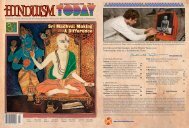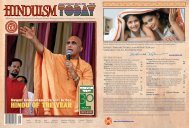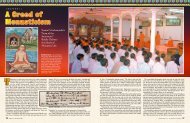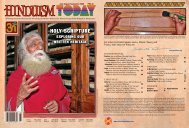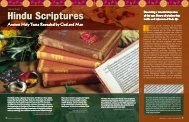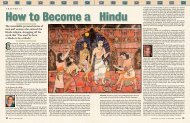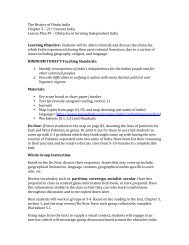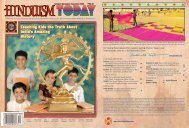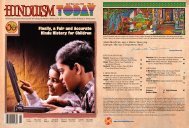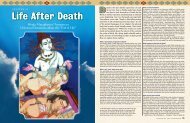Hinduism Today July 2007 - Cover, Index, Gatefold, Front Articles
Hinduism Today July 2007 - Cover, Index, Gatefold, Front Articles
Hinduism Today July 2007 - Cover, Index, Gatefold, Front Articles
You also want an ePaper? Increase the reach of your titles
YUMPU automatically turns print PDFs into web optimized ePapers that Google loves.
ayurveda<br />
Teenage Depression<br />
Beware the causes and the drawbacks of standard<br />
treatments for this unfortunately common ailment<br />
b y D r . v i r e n d e r s o d h i<br />
our out of 100 teenagers become seriously<br />
depressed each year. Everybody feels sad now and then;<br />
but if they’re sad most of the time, and it’s causing problems<br />
in school and with relationships with family and<br />
friends, they may be clinically depressed.<br />
What is depression? Clinical depression is a serious illness<br />
that can affect anybody, including teenagers. It can affect<br />
their thoughts, feelings, behavior and overall health. Common<br />
symptoms are poor appetite, insomnia or excessive sleep<br />
habits, hyperactivity or inactivity, loss of interest or pleasure<br />
in usual activities, fatigue, feelings of worthlessness or self-reproach,<br />
diminished ability to think or concentrate, and recurrent<br />
thoughts of death or suicide. Intense bouts of depression<br />
that last for weeks at a time are called major depression. A less<br />
severe form can linger at a low level for years. A third form is a<br />
depressive reaction to a specific life event, such as a death, divorce<br />
or other loss, when the adjustment to the loss takes longer than<br />
normal or is more severe than expected and interferes with the<br />
person’s daily activities. And there is another condition, bipolar<br />
disorder (also called manic depressive illness), in which periods of<br />
major depression alternate with periods of abnormally high mood<br />
and extreme bursts of unusual activity, called mania.<br />
What causes depression? Depression can be the result of psychological<br />
as well as physiological factors. The predominant psychological<br />
theory asserts that depression is the result of habitual<br />
feelings of pessimism and hopelessness. The chief physiological<br />
theory points to imbalances of monoamine neurotransmitters such<br />
as serotonin, epinephrine, and norepinephrine. Serotonin deficiency<br />
is the most common biochemical cause.<br />
It is important to screen for the various simple, organic factors<br />
which are known to contribute to depression. These include nutrient<br />
deficiency, hypoglycemia (low blood sugar), hypothyroidism<br />
(low thyroid function) and drugs—not only prescription and illicit<br />
drugs, but also alcohol, caffeine, nicotine, etc. Although it is uncommon<br />
to perform lab tests in the diagnosis of depression, I run a<br />
thorough blood and urine test for these factors to determine if any<br />
of them is causing a chemical imbalance.<br />
The brain requires a constant supply of blood sugar to function<br />
properly, so hypoglycemia must be avoided. Symptoms of hypoglycemia<br />
can range from mild to severe and can include depression,<br />
anxiety, irritability, fatigue, headache, blurred vision, mental<br />
confusion, incoherent speech and convulsions. Several studies have<br />
shown that hypoglycemia is common in depressed individuals. Simply<br />
eliminating from the diet refined carbohydrates and caffeine,<br />
which can aggravate hypoglycemia, is sometimes sufficient treatment<br />
for those whose depression results from hypoglycemia.<br />
Food allergy is a causative factor in other cases of depression.<br />
Eliminating offending foods can bring about tremendous relief.<br />
A deficiency of any single nutrient can alter brain function and<br />
lead to depression, anxiety and other mental disorders. Particularly<br />
essential in this context are vitamin B12, folic acid and other B<br />
vitamins, and the omega-3 fatty acids.<br />
What are the standard treatments<br />
for depression? Most people are treated<br />
with counseling, or psychotherapy, which<br />
is talking about feelings with a trained<br />
psychologist who can help one change the<br />
relationships, thoughts or behaviors that<br />
are causing the depression. Your child<br />
may feel depressed because she thinks her<br />
life is bad. What if she is wrong? What if<br />
her future holds a lot more promise than<br />
she thinks? When someone is depressed,<br />
they are in a rut, and they can’t see anything<br />
positive. They need to talk to someone<br />
who can help them get out of that<br />
rut. Young people should seek help from<br />
parents or their school counselor. Parents<br />
need to take a very active role by first recognizing<br />
that their child is depressed and<br />
then providing all the help they can.<br />
Some people are helped with counseling<br />
and medicine. Doctors routinely<br />
prescribe a number of different antidepressant<br />
medications. These differ in their<br />
side effects and levels of effectiveness.<br />
The most common drugs prescribed today<br />
for depression are the selective serotonin<br />
reuptake inhibitors (SSRIs), including<br />
fluoxetine (Prozac), fluvoxamine (Luvox), paroxetine (Paxil) and<br />
sertraline (Zoloft). Other similar drugs are venlafaxine (Effexor),<br />
nefazodone (Serzone), clomipramine (Anafranil) and bupropion<br />
(Wellbutrin). All of these drugs correct decreased levels of specific<br />
neurotransmitters in the blood that can cause or contribute to<br />
depression.<br />
Do these drugs pose risks to children and teens? In 2003 the<br />
British Medicines and Healthcare Regulatory Agency banned the<br />
pediatric use of all SSRIs except Prozac due to evidence from<br />
clinical trials showing that children taking SSRIs were driven to<br />
acute emotional distress, leading some of them to become suicidal<br />
and homicidal. In December, 2003, after reviewing 22 clinical<br />
trials showing that children using nine SSRIs were on average almost<br />
twice as likely to become suicidal, senior US Food and Drug<br />
Administration epidemiologist Dr. Andrew D. Mosholder recommended<br />
a ban on pediatric use of the drugs. The FDA barred<br />
him from presenting his conclusions publicly and commissioned<br />
researchers at Columbia University to re-examine the data. Their<br />
findings were virtually the same. In September, 2004, the FDA<br />
released a long-awaited analysis concluding that young patients<br />
taking antidepressants could be at increased risk for self-harm.<br />
They directed manufacturers to add black-box warnings (the most<br />
serious kind of warning) on doctor labeling to describe the increased<br />
risk of suicidality in young people being treated with antidepressants.<br />
The label wording includes a reminder that Prozac is<br />
currently the only medication approved to treat depression in children<br />
and adolescents. The FDA also planned to develop a patient<br />
medication guide to be given along with prescriptions.<br />
Although increased risk of suicidal behavior in youth may be the<br />
worst side effect of antidepressant drugs, there are many others.<br />
In my article in the coming October/November/December, <strong>2007</strong>,<br />
issue of <strong>Hinduism</strong> <strong>Today</strong> I will offer natural remedies from<br />
the ayurveda tradition that I have found to be effective in the<br />
treatment of depression.<br />
dr. virender sodhi holds an M.D. (Ayurveda) from India and a<br />
N.D. from Bastyr College of Naturopathic Medicine, USA. E-mail:<br />
drsodhi@ayurvedicscience.com. Web: www.ayurvedicscience.com.<br />
B o o k s<br />
The Vedic<br />
Wedding<br />
Understanding what it<br />
all means, step by step<br />
By Tara Katir, Washington<br />
he ritual of circumambulating<br />
the sacred fire binds a Hindu couple<br />
together in a tradition that has been<br />
followed in India for thousands of years.<br />
To sustain these customs outside India is Dr.<br />
A.V. Srinivasan’s stated intention in his new<br />
book, The Vedic Wedding: Origins, Tradition<br />
and Practice (Periplus Line LLC, 268<br />
pages). Srinivasan explains, “The inspiration<br />
came from the young Indians in the United<br />
States who sought my advice in the past<br />
three decades and asked me to officiate at<br />
their weddings. I have been impressed by<br />
their genuine interest in understanding Vedic<br />
wedding practices and philosophy.”<br />
Srinivasan’s book is a solution for contemporary<br />
Hindu couples in the West who wish<br />
to fully comprehend their marriage ceremony.<br />
Chapters on the Hindu philosophy of<br />
marriage, the origins of the ceremony in the<br />
Vedas, Shastras, Grihya Sutras and popular<br />
traditions and customs, provide good preparation<br />
for understanding the ritualistic ceremony,<br />
which is covered in chapter four. In<br />
addition, readers will find detailed instructions<br />
for required accoutrements, music<br />
selection, rehearsal, bridal attire and cosmetics,<br />
special pujas done by the bride and<br />
groom and a bevy of additional ceremonies<br />
one may choose to include. There is even a<br />
practical section on homa fire safety. The<br />
book is well researched and a welcome help.<br />
the vedic wedding, origins, tradition and practice<br />
by a.v. srinivasan, periplus line llc, p.o. box 56, east<br />
glastonbury, ct 06025-0056, 2006. 268 pages.<br />
Hindu Posters<br />
o give an accurate<br />
portrayal of the rich Hindu<br />
cultural heritage, Hindu<br />
Swayamsevak Sangh<br />
USA created a popular exhibition<br />
presenting Hindu dharma<br />
and culture through a series of<br />
30 posters (example at right),<br />
which have now been compiled<br />
into Hindu Culture and<br />
Dharmic Traditions from India.<br />
The posters illustrate the firm<br />
roots of our ancient dharma<br />
in the archeological past and show how<br />
<strong>Hinduism</strong>’s lofty cosmological laws are finding<br />
themselves accepted by some modern<br />
astronomers and physicists. Hindu dharma,<br />
way of living and temple worship, the exhibition<br />
points out, have found a welcoming<br />
home in America after influencing Cambodia,<br />
Indonesia, Malaysia and various Caribbean<br />
countries over the centuries. Yoga<br />
and ayurveda, once the privied province<br />
of ancient Hindu India, are now the rage<br />
throughout the West. Teachers and parents<br />
should bring this book to the attention of<br />
school curriculum directors. It is a creative<br />
teaching tool to help counter the misinformation<br />
published in textbooks regarding Indian<br />
religious practices and history.<br />
hindu culture and dharmic traditions from india,<br />
publisher hss, usa, 121 hawthorne court, rockaway,<br />
nj 07866 (30 pages) $15. www.hssus.org.<br />
Hanuman Twice!<br />
uneel gomber, devotee of lord<br />
Hanuman and founder of J. B. Charitable<br />
Trust, has compiled two lovely<br />
books on Lord Hanuman: The World<br />
of Lord Hanuman and The Visual Encyclopedia<br />
of Lord Hanuman (J.B. Charitable<br />
Trust, 188 and 247 pages respectively). For<br />
The World of Lord Hanuman, Gomber collected<br />
material from 51 websites devoted to<br />
Hanuman and compiled it into 31 articles.<br />
Gomber states, “These sites, which are<br />
maintained by highly learned international<br />
scholars, provide a wonderful insight into<br />
the references on Lord Hanuman drawn<br />
from various sacred and religious scripture.<br />
By the grace of Hanumanji, I have been able<br />
to compile the storehouse of information<br />
and knowledge of these websites into a collection<br />
of articles in this book.”<br />
The result is a marvelous volume<br />
that guides readers through<br />
the long and complicated details<br />
of Lord Hanuman’s life and relationship<br />
with Lord Rama.<br />
In 2004, Suneel Gomber established<br />
the Museum of Hanumat<br />
Sangrahalaya, “a vast collection<br />
of rare books, paintings, Deities<br />
and murals depicting Lord Hanuman<br />
in various divine forms.”<br />
The Visual Encyclopedia of Lord<br />
Hanuman is a 247-page compilation of the<br />
many sketches, paintings and photographs<br />
belonging to the Hanuman Museum. The<br />
art is presented in brilliant full color whenever<br />
possible; a caption under each picture<br />
details its origin. Whether you are a devotee<br />
of Lord Hanuman or just love the Ramayana<br />
and Indian art, these two books are great<br />
additions to your personal library.<br />
the world of lord hanuman by suneel gomber and<br />
prashant gupta, 188 pages, rs 350. the visual encyclopedia<br />
of lord hanuman, suneel gomber, english<br />
text by dr. n.s.r. sastry, hindi translation by dr.<br />
yogesh praveen, 247 pages, rs 695. both published by<br />
j.b. charitable trust (regd.), 14/1192, indira nagar,<br />
lucknow 226 016, u.p., india.<br />
<strong>Hinduism</strong> for<br />
Children<br />
ivekananda centre london<br />
has published a new book by Seeta<br />
Lakhani, Primary <strong>Hinduism</strong>, as part<br />
of a series of textbooks (including<br />
<strong>Hinduism</strong> for Schools for older children)<br />
designed to ensure that <strong>Hinduism</strong> taught in<br />
the West is “both comprehensive and comprehensible.”<br />
Utilizing appealing narratives and colorful<br />
images to make <strong>Hinduism</strong> interesting<br />
and exciting for the very young, this new<br />
book is designed for use by 6- to 13-year<br />
olds (“key stages” 1 to 3 in the UK school<br />
system). In simple language and informative<br />
illustrations, it presents easy-to-understand<br />
explanations of Hindu<br />
beliefs and practices.<br />
A companion website,<br />
www.hinduism.fsnet.<br />
co.uk/, offers supporting<br />
resources for the books.<br />
hinduism for schools by<br />
seeta lakhani, publisher<br />
vivekananda centre london,<br />
6 lea gardens, wembley,<br />
middlesex ha9 7s3, 133 pages,<br />
£12. for uk and international<br />
order from www.<br />
vivekananda.co.uk. in usa,<br />
www.minimela.com.<br />
62 hinduism today j u ly / au g u s t / s e p t e m b e r , 2 0 0 7<br />
j u ly / au g u s t / s e p t e m b e r , 2 0 0 7 h i n d u i s m t o d ay 63



